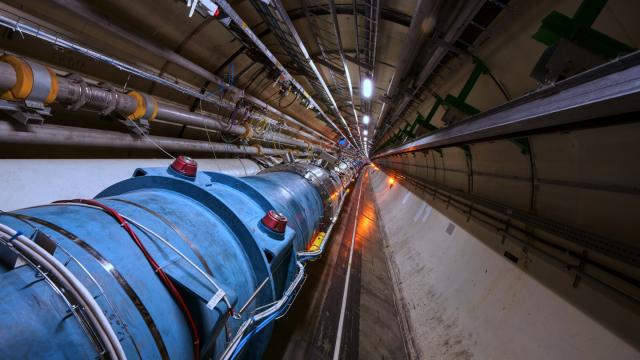You can feasibly put anything inside the world’s largest physics experiment, CERN’s Large Hadron Collider in Switzerland, so long as it can be vaporised. You could even stick a sandwich in there. But for the first time, scientists have accelerated an atomic nucleus with electrons still attached.
The Large Hadron Collider’s goal, in short, is to bestow subatomic particles with energies otherwise unachievable on Earth, hoping to uncover the fundamental nature of the universe. The LHC typically accelerates protons, the positive pieces of atomic nuclei, or entire atomic nuclei.
Usually those nuclei have been stripped of their negatively charged electrons, but in this case, a beam of lead “atoms” — technically they’re ions — travelled through the accelerator with at least one electron attached. The physicists hope to one day use these accelerated atoms in a next-generation experiment.
“We’re investigating new ideas of how we could broaden the present CERN research programme and infrastructure,” LHC engineer Michaela Schaumann said in a press release. “Finding out what’s possible is the first step.”
The LHC typically starts with neutral lead atoms or a bottle of hydrogen gas, which travel through a chain of smaller particle accelerators. Oscillating magnetic fields strip many of the electrons from the lead atoms. But the atoms lose their remaining electrons when they pass through a metal foil before entering the 27km-round ring.
Schaumann and her team adjusted the width of the foil so that one electron remained attached to the lead atom. The scientists then adjusted the LHC to maintain the beam of particles with one more electron than the lead ions in the experiment usually have.
The researchers were able to keep the beam circulating in the Large Hadron Collider for two hours, according to the release.
Aside for being a first, the experiment is a proof-of-concept for a proposal that could potentially turn the LHC into a gamma ray factory. If realised, the LHC would produce the highest-energy manmade light ever.
This light could be turned into secondary beams for all sorts of research purposes, including the study of dark matter. It “could open new research opportunities in a vast domain of uncharted fundamental physics and industrial application territories,” according to the proposal.
Such a gamma ray factory would involve hitting one of these single-electron atom beams with a laser, causing the electron to hop up to a higher atomic energy level. The electron would then fall back to its ground state, releasing a light particle. But since the atom is already travelling at near light-speed, the light particle’s wavelength would be squeezed, greatly increasing its energy.
At least one CERN accelerator physicist who wasn’t present for this study, John Jowett, told Gizmodo he was impressed by Schaumann’s work and thought it was an exciting event. As this was just a first test, Schaumann now hopes to run the beam at a higher intensity.
Scientists at the LHC are often trying new things — last year, they accelerated xenon atoms instead of the usual lead. The experiment is also receiving an upgrade that will let physicists gather more data faster. It will take many more experiments like these to unravel the mysteries of particle physics.
[CERN]
